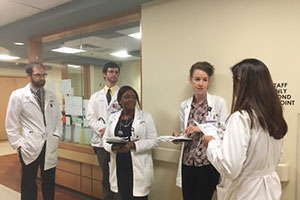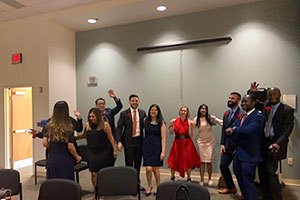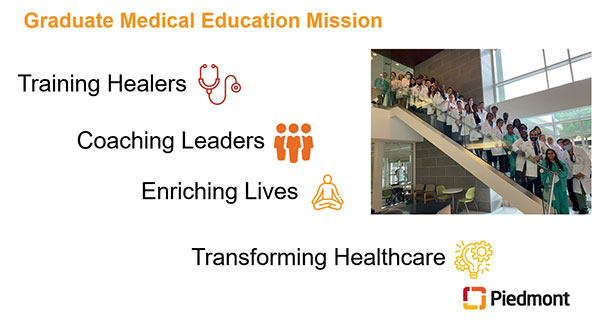Curriculum & Schedules - Internal Medicine
Our curriculum is based on a pyramid model where each successive year builds upon the last. The foundation is the PGY-1 year, where residents learn how to survive as a physician. Residents then build upon these skills in PGY-2, learning how to lead. In the final year, residents’ curricula are personalized to help them succeed in their future careers.
PGY-1 Year
How to Survive

Residents learn data collection, synthesis and how to accurately and meaningfully present information. They learn how to prioritize the care of sick patients and identify those who require additional interventions. During the year, they are exposed to inpatient, outpatient, critical care and infectious diseases.
PGY-2 Year
How to Lead

Residents begin to hone their leadership skills by leading teams in inpatient and outpatient settings. They serve as committee and tribal leaders and take over the program activities, such as Clinically Relevant Questions (CRQ) and quality improvement (QI) initiatives. During the year, they are exposed to inpatient, outpatient, electives, neurology and emergency medicine.
PGY-3 Year
How to Succeed

Residents are expected to perform tasks correctly with increasing independence. They must proficiently and effectively manage complex medical patients and understand when there is a need for an appropriate referral. They will further improve their communication and health promotion skills by teaching their peers and other healthcare team members. Senior residents gain leadership experience through consultations, hospitalist, rural medicine, geriatrics and Business of Medicine rotations.
By graduation, our residents are:
- Able to provide patient-centered, high-value, cost-effective care
- Embrace diversity and understand the impact health disparities have on medical care
- Adept at using health information technology to improve the care and education of their patients and the community
- Committed to life-long learning and professional development
- Demonstrate compassion, integrity and respect for others
- Function effectively as leaders or members of a high-functioning healthcare team.

Sample Curricula
Ambulatory | Inpatient Medicine | Office Ambulatory | Rural Health | Seeing the Other Side (SOS) | Art of Doctoring | Ultrasound | Business of Medicine
Schedules
4+2 Schedule
The program runs on the 4+2 schedule model as a way to ensure resident well-being by preventing work compression.
Residents typically complete 4 weeks of an inpatient rotation (Wards or ICU) followed by 2 weeks of Ambulatory or Elective. During their inpatient rotations, they do not attend continuity clinics, allowing residents to focus on the patients that require their immediate attention.
PGY-1 Scheduler
- Wards: 16 Weeks
- Ambulatory: 12 Weeks
- Night Medicine: 4 Weeks
- ICU: 4 Weeks
- Patient Safety and Quality Improvement: 2 Weeks
- Infectious Disease: 4 Weeks
- Electives: 4 Weeks
- Vacation: 4 Weeks
PGY-2 Schedule
- Wards: 12 Weeks
- Ambulatory: 12 Weeks
- ICU: 4 Weeks
- Night Medicine: 4 Weeks
- Seeing the Other Side (SOS): 2 Weeks
- Emergency Medicine: 4 Weeks
- Neurology: 4 Weeks
- Electives: 4 Weeks
- Vacation: 4 Weeks
PGY-3 Schedule
- Wards: 10 Weeks
- Ambulatory: 12 Weeks
- Office Ambulatory: 2 Weeks
- Business of Medicine: 2 Weeks
- ICU: 4 Weeks
- Night Float: 4 Weeks
- Geriatrics: 4 Weeks
- Electives: 8 Weeks
- Patient Safety & Quality Improvement: 2 Weeks
- Vacation: 4 Weeks